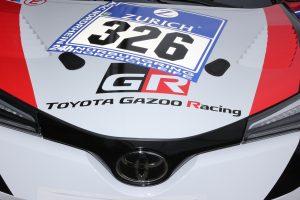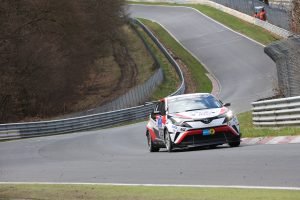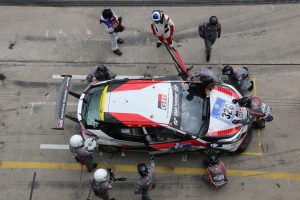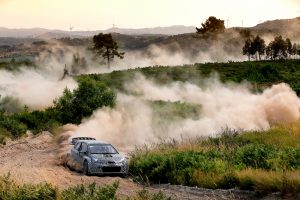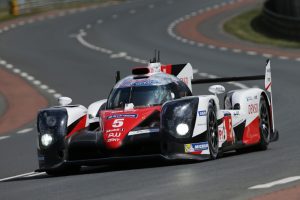Toyota Gazoo Racing
Paris motor show press information
Toyota Gazoo Racing embody Toyota’s commitment to push every limit to make ever-better cars through motorsport activities. “What we learn at the very limits of performance, we seek to transfer into benefits for everyday driving.”
Reaping the benefits of motorsport participation
Over the years Toyota has participated in many forms of motorsport, including Formula One, the World Endurance Championship and the Nürburgring 24 Hours endurance race. These activities have been conducted by separate entities within the company, such as Toyota Racing, Lexus Racing and Gazoo Racing.
Gazoo Racing first took part in the Nürburgring 24 Hours in 2007 with two used Toyota Altezza race cars and a team of mechanics drawn from different Toyota departments, working to the maxim “the roads build the people and the people build the cars”.
This was in line with thinking of Toyota’s founder, Kiichiro Toyoda, who said in 1952: “Motorsport is more than just entertainment. It is vital to the development of the car industry. Just as athletes test their capabilities by competing with all their strength in the Olympics, automakers use racing as an opportunity to push a vehicle’s performance to the limits and compete for supremacy, enabling them to discover new ways of advancing automotive technology.”
With this in mind, Toyota united its motorsports activities into Toyota Gazoo Racing in April 2015, giving motorsports a fundamental position in its commitment to make ever-better cars.
Toyota’s technology developments have been further improved through competing in races, and these advances have been used to improve the performance and quality of its road cars. Between entering its first World Endurance Championship race in 2012 and winning the championship in 2014, Toyota’s experience with powertrain engineered for its TS030 and TS040 LMP1 race cars significantly contributed to the successful development of hybrid powertrain technology for its road-going models, in areas such as downsizing and motor cooling.
By participating in motorsport Toyota has stepped out of its comfort zone and broadened its knowledge. It has been able to improve its skills and thereby develop its human resources performance. Last, but not least, it also provides a means for Toyota to convey the excitement of driving to its customers and fans and to share its passion with them.
With Toyota’s return to the World Rally Championship in 2017, Toyota Gazoo Racing have identified another highly demanding competition series where it can push machines to the limit in the pursuit of “ever-better cars”.
TOYOTA GAZOO RACING ACTIVITES IN EUROPE
FIA World Endurance Championship (WEC)
The FIA World Endurance Championship includes endurance races of six hours or more in locations across Europe, the Americas and Asia. The highest profile event is the 24 Hours of Le Mans, a historic race that is part of international motorsport’s “Triple Crown” and the pinnacle of endurance racing.
Since its first entry in 1985, Toyota has participated in the event 18 times, coming within one lap of victory in 2016. One of the team’s TS050 race cars led convincingly until the closing minutes, only to be forced into retirement with victory in sight. As a modest consolation, the sister car finished in second place.
Taking on the challenge of Le Mans requires exceptional speed and reliability and Toyota Gazoo Racing continue to refine its racing hybrid system with ever-more sophisticated technologies. This system was developed in-house at Toyota, with members of the development team joining the race crew at the event as well. The team is made up of a diverse group of people – all of different ages and levels of experience – but all of them share the common goal of “making ever-better cars”.
Nürburgring 24 Hours race
Every year factory-backed and privateer teams from around the world travel to Germany to compete in “the world’s toughest race” at the Nürburgring. This year marked Toyota Gazoo Racing’s 10th participation in the event, fielding a Lexus RC and RC F and a Toyota C-HR Racing.
In a field of 158 cars, the Toyota C-HR Racing – a development of Toyota’s new compact crossover model – finished 84th overall and third in its class on its maiden outing. The Lexus RC retired because of drivetrain issues, but the RC F took 24th place overall and first place in its class.
The Nürburgring 24 Hours plays an important role in helping Toyota train its personnel, giving mechanics, engineers and test drivers from its road car division the chance to be actively involved in a sports environment.
Toyota’s aim remains the same as when it first contested the event a decade ago: to engage in demanding motorsports and incorporate the insights gained in its quest to “make ever-better cars”.
FIA World Rally Championship (WRC)
The FIA World Rally Championship is a merciless and compelling high-speed competition fought out on all kinds of road – from smooth asphalt to wilderness tracks – around the world. Drivers have to make split-second judgements about road conditions in one of the most demanding challenges in motorsport.
Building a successful world rally car requires much more than just engineering theory, it about using knowledge and first-hand experience to craft a vehicle that can be driven to the limit on every type of road. With this in mind, Toyota Gazoo Racing decided to take on the WRC, joining the field in 2017.
Its car, the Toyota Yaris WRC, is nearing completion in a project led by four-time world champion Tommi Mäkinen. Mäkinen explains: “The most important ingredient in creating a winning vehicle is to have a group of people with the same goal who all find joy in what they do. We want to show the world a team coming together under Toyota’s ‘I love cars!’ spirit as we work diligently towards our goals.”
The meaning of Gazoo
Today “Gazoo” has the same kind of meaning as “garage” – an intimate place where people work together to improve the smallest details, aiming to deliver ever-better cars and services to every customer, in every garage. As such, the name embodies the spirit that drives Toyota Gazoo Racing.
The origin of the name dates back nearly 20 years and the creation of Gazoo.com, a website that brought together images of cars in stock at each dealership. The name Gazoo derived from the Japanese word “gazō” which means image or photo. Although the use of imagery on website is commonplace today, it was a radical step for the Japanese motor industry in the mid-1990s, when internet technology was in its infancy.
Gazoo.com offered customers a wide choice of products, allowing them to find the best deal available. This is where the philosophy of providing ever-better cars to Toyota customers originates from.
Interview with Koei Saga, Chief Officer and Technical Director and Shigeki Tomoyama, Deputy Chief Officer and Marketing Director, Toyota Gazoo Racing
What is the purpose of Toyota Gazoo Racing?
Saga-san: The purpose of Toyota Gazoo Racing is quite straightforward and goes back to the basic question of why we participate in motorsport.
“Our founder, Kiichiro Toyoda, left us a written text saying that “motorsports are vital to the evolution of car making and the entire auto industry”. Once you accept this principle, it is clear that motorsport is both very important and always necessary. It is not something to pick up when times are good, or drop when times are hard.
“That is why last year, we decided to get back to this founding ideal and united Toyota’s motorsports activities in Toyota Gazoo Racing, clarifying the role of Toyota’s motorsports in its making of ever-better cars. We also established the Toyota Gazoo Racing Factory, which includes motorsports-related marketing, vehicle development and technical support functions, previously all managed by separate divisions. By doing so, we are once again placing motorsports centrally, to develop better technology, to nurture our people and to reach out to our many fans around the world.”
What role has the Nürburgring 24 Hours race played in the evolution of Toyota Gazoo Racing?
Tomoyama-san: “The Nürburgring 24 Hours race was the starting point for Toyota Gazoo Racing. In 2007 we competed there for the first time as Gazoo Racing. It was not easy because the team was not well-known in Europe and we have a very low budget. We started with two Altezza (a Japanese version of the Lexus IS). People participated voluntarily and all the modifications to the car were done by our staff. Even half the drivers were members of our staff, including our president Akio Toyoda himself, who still gives us his full support.
“Every year since then we have taken promising young engineers and mechanics from our various R&D divisions and put them in our team for the Nürburgring 24 Hours. At the end of the year they return to their original divisions with the experience and knowledge they have gained throughout the development of that year’s race car and from the race itself, sharing what they have learned with their colleagues with the ultimate aim of building better production cars.”
Can you explain what you mean by “ever-better cars”?
Saga-san: “Personally, I am confident that we already make good cars at Toyota. But our objective and purpose is to continually make our cars better. That means better technology, better functionality and cars that are ultimately more user-friendly, more fun to drive and more secure. At the same time, we have many strict regulations worldwide when it comes to the environment, which we strive to meet.
“For example, we’re already on track with our hybrid systems, but they must also be capable of delivering a sporty driving experience. It’s a kind of dream for me personally, to have everyday hybrid road cars that are comfortable, but are equally engaging to drive on a track.”
You both also have other roles within Toyota Motor Corporation, with Saga-san as Chairman of the Powertrain Company and Tomoyama-san as President of the Connected Company. How do they relate to your motorsport roles?
Saga-san: “I used to be an engine designer, and the last engine I designed was the Century V12. I am a firm believer that our activities in the WEC are beneficial for our company. The WEC wants to have hybrid cars participating in its series, and we are the leader in hybrid cars in the market, so there is a natural fit. When we think of the future, we have to get even better in this field, so what better platform than the WEC to create ever-better cars.”
Tomoyama-san: “Race cars are already connected through detailed telematics systems, but IT, IoT (Internet of Things) and connectivity are very important technologies that have to be implemented in our future cars.
“Cars need to be secure and user-friendly, particularly with an ageing population. However, we don’t want to produce boring cars with all this IT stuff. ‘Fun to Drive’ is a key promise we want to deliver to all our customers. We are looking at how technology can help make cars both fun to drive as well as secure and user-friendly – and our learning from motorsport can help us in this regard.”
What does success look like for Toyota Gazoo Racing?
Saga-san: “We have a number of short-term goals, such as winning the 24 Hours of Le Mans and becoming WRC champions once again. But just as importantly, we want to convey the Gazoo spirit in all that we do. We want to take things step by step and achieve small successes, but there is no ultimate goal because it’s a never-ending challenge.”

